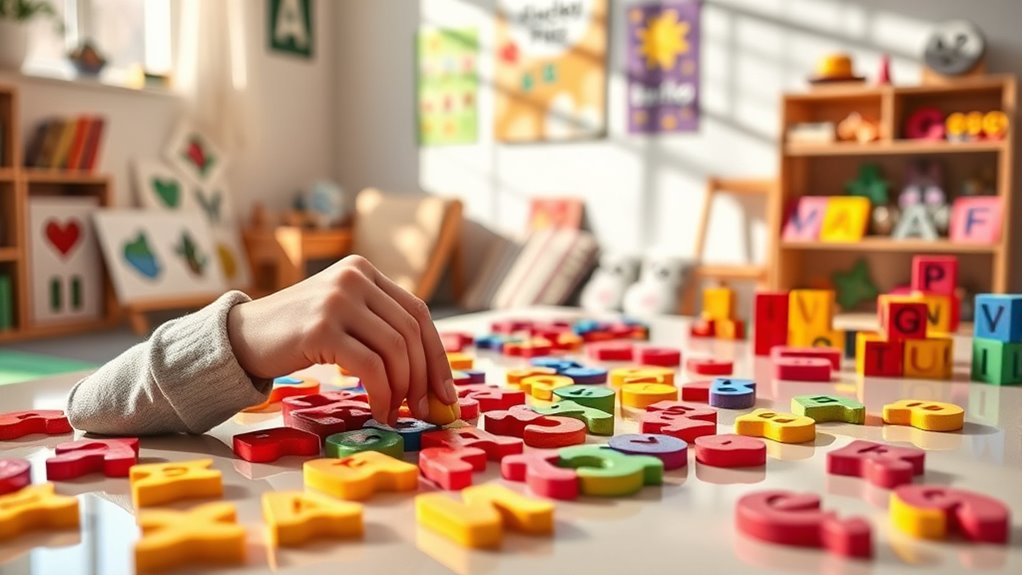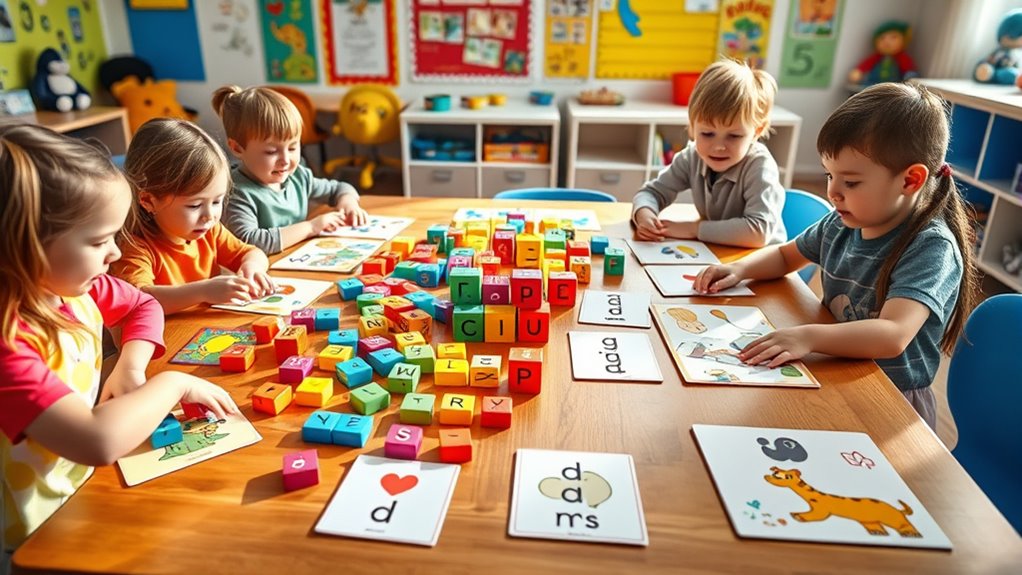If you’re looking for the best language development puzzles that make learning fun and effective, I’ve got you covered. From self-correcting spelling games and sentence-building puzzles to bilingual alphabet jigsaws and sign language practice tools, there are options for every age and skill level. These puzzles promote vocabulary, fine motor skills, and confidence while keeping kids engaged. Keep exploring to discover how you can find the perfect fit for your child’s language growth.
Key Takeaways
- Features like self-correcting design and colorful graphics enhance engagement and confidence in language learning.
- Bilingual and multilingual puzzles support vocabulary development across different languages.
- Themed puzzles, including crossword and sentence-building activities, reinforce grammar, sentence structure, and comprehension.
- Tactile and interactive puzzles improve fine motor skills and focus while making learning hands-on and fun.
- Durable materials and portable designs ensure long-lasting use and easy accessibility for learners.
The Learning Journey Match It! Letters Self-Correcting Spelling Puzzles for Ages 4
If you’re looking for a fun and effective way to support early literacy skills, The Learning Journey Match It! Letters Self-Correcting Spelling Puzzles for Ages 4 make learning both interactive and enjoyable. These colorful puzzles feature 20 self-correcting sets that help children recognize letters, form words, and understand spelling. The pieces only fit when correct, reducing frustration and building confidence. Designed for children ages 4-7, they promote problem-solving, motor skills, and focus. Made from durable cardboard, they withstand classroom or home use. Overall, these puzzles turn early reading into a rewarding activity that encourages independent learning and vocabulary growth.
Best For: young children aged 4-7 who are developing early reading, spelling, and vocabulary skills in classroom or home settings.
Pros:
- Self-correcting design helps build confidence and independence in learning.
- Durable cardboard pieces withstand frequent use and handling.
- Engages children with colorful, visually appealing graphics that promote active participation.
Cons:
- The included word list is not provided in the product description, making it harder for teachers or parents to plan activities.
- Some learners may find the mix of CVC and more advanced vowel patterns confusing initially.
- Slightly limited to basic three-letter words, which may not challenge more advanced early readers.
Melissa & Doug Spanish See & Spell Educational Language Learning Toy
Looking for a fun, interactive way to introduce young children to Spanish language skills? The Melissa & Doug Spanish See & Spell is a sturdy, wooden puzzle set perfect for ages 4-7. It includes 8 double-sided puzzle boards and 64 colorful wooden letters, helping kids learn sight words like “gato,” “casa,” and “sol.” The pieces fit securely into outlined slots, promoting letter recognition, spelling, and fine motor skills. Made of FSC-certified wood, it’s durable and eco-friendly. Kids enjoy fitting the letters, enhancing their vocabulary and early reading skills. Many parents praise its quality and versatility for screen-free, engaging language learning at home or on the go.
Best For: young children aged 4-7 who are native Spanish speakers or learning Spanish and want a hands-on, screen-free educational toy to develop spelling, vocabulary, and early reading skills.
Pros:
- Durable, eco-friendly FSC-certified wooden construction with engaging, colorful illustrations
- Promotes multiple skills including letter recognition, spelling, fine motor development, and bilingual vocabulary building
- Organized storage in a sturdy wooden crate makes it easy to keep pieces tidy and portable
Cons:
- Limited to Spanish vocabulary and may require supplementary tools for broader language exposure
- Some users wish for additional letters or more variety in words to expand learning options
- The set may be too simple for advanced learners, requiring additional resources for continued challenge
110PCS Sentence Building Puzzles for Kids Learning Sentences, Early Reading & Writing Educational Toy
These PCS Sentence Building Puzzles are an excellent choice for young children, especially those in kindergarten through 2nd grade, who are developing their early reading and writing skills. With 110 double-sided puzzle cards, kids can practice sentence structure, punctuation, spelling, and grammar in a fun way. The color-coded system helps children recognize parts of speech easily, while the sturdy design guarantees durability for frequent use. The inclusion of blank cards encourages creativity and independent sentence formation. Overall, this educational toy promotes language development, critical thinking, and confidence in reading and writing, making learning engaging and effective for young learners.
Best For: young children in kindergarten through 2nd grade who are developing early reading, writing, and language skills.
Pros:
- Engages children with fun, interactive sentence-building activities.
- Color-coded parts of speech simplify grammatical recognition and learning.
- Durable, double-sided cards allow for repeated use and creative customization with blank cards.
Cons:
- May be too simple for older children or advanced learners.
- Requires adult supervision for writing on blank cards, especially for younger children.
- Limited to basic sentence structures, which might not challenge more experienced students.
Spanish Crossword Puzzles for Practice and Fun (Dover Dual Language – English to Spanish)
Spanish Crossword Puzzles for Practice and Fun (Dover Dual Language – English to Spanish) are an excellent choice for learners seeking engaging ways to reinforce vocabulary and translation skills. These puzzles are suitable for basic to intermediate Spanish learners (A2 to low B1) and are enjoyed by students, gift recipients, children, and older adults alike. Organized into levels—easy, moderate, and difficult—they feature themed puzzles like countries, animals, and careers. While the small font and limited space can be challenging, users appreciate the bilingual format and vocabulary focus. Overall, they’re a fun, educational tool that makes practicing Spanish both effective and enjoyable.
Best For: learners of basic to intermediate Spanish (A2 to low B1) seeking an engaging and educational way to reinforce vocabulary, translation, and comprehension skills through themed crossword puzzles.
Pros:
- Offers a bilingual format that supports both English and Spanish language practice.
- Organized into levels (easy, moderate, difficult) suitable for various skill stages.
- Themed puzzles make learning relevant and fun, covering topics like countries, animals, and careers.
Cons:
- Small font size and limited answer space can make puzzles difficult to read and complete.
- Layout could be improved with larger boxes and more spacious design for better usability.
- Not entirely in Spanish as advertised; includes bilingual elements that may be confusing for some learners.
Language Development From Theory to Practice
If you’re a Speech-Language Pathologist or a psychology major seeking a thorough guide, “Language Development From Theory to Practice” is an excellent resource. It offers detailed insights into how children’s speech and language skills evolve with age, making complex concepts accessible and applicable. The book’s clear, engaging format is perfect for classroom use or professional development, whether in person or via its portable Kindle version. Its well-designed pages support highlighting key ideas, helping you retain vital information. This practical resource bridges theory and real-world application, giving you the tools to understand, assess, and support language development effectively.
Best For: Speech-Language Pathologists and psychology majors seeking an in-depth, practical guide on language development for educational and professional growth.
Pros:
- Provides meticulous detail on speech and language development across childhood.
- Clear, engaging, and easy-to-read format suitable for classroom and professional use.
- Portable Kindle version allows for flexible, on-the-go access and supports highlighting for study.
Cons:
- Exterior pages and cover show signs of wear and may feel fragile, especially with frequent handling.
- As a rental, the physical durability may be limited over time.
- Slightly dense content may require focused reading for full comprehension.
ASL Word Search Puzzle Book for Sign Language Learning
For beginners learning American Sign Language, the ASL Word Search Puzzle Book is an excellent tool to reinforce the alphabet and fingerspelling skills. It helps memorize manual signs and improves quick recognition of finger-spelled words, enhancing reading abilities. The large pages make it easy to differentiate letters, and the fun activities keep practice engaging. With 110 puzzles and solutions, it offers repeated use and self-checking. Users find it a practical, enjoyable way to boost fingerspelling proficiency, though some puzzles may contain errors. Overall, it’s a valuable resource for sign language learners and interpreters seeking a hands-on, interactive learning experience.
Best For: beginners and learners of American Sign Language seeking an engaging, practical way to reinforce fingerspelling and alphabet recognition.
Pros:
- Enhances memorization of ASL manual alphabet and fingerspelling skills.
- Large pages and clear layout support easy differentiation of signed letters.
- Provides 110 puzzles with solutions for repeated practice and self-assessment.
Cons:
- Some puzzles may contain errors or extra words not listed, causing confusion.
- Occasional frustration due to inconsistencies in answer keys.
- Puzzles can be challenging for very new learners or those with limited sign language experience.
Language Development: Foundations, Processes, and Clinical Applications
Language Development Puzzles is an excellent resource for clinicians, educators, and students seeking an extensive understanding of how language develops and can be supported. This book offers thorough insights into foundational theories, developmental processes, and practical clinical applications. While it provides valuable content, some physical issues, like a loose table of contents, may affect usability. Additionally, the presence of typos throughout the text and online resources can hinder clarity and reliability. Despite these flaws, the core material remains relevant for understanding language development, making it a useful, if imperfect, tool for those working to enhance language learning and intervention strategies.
Best For: clinicians, educators, and students seeking an in-depth understanding of language development with practical applications despite some physical and typographical flaws.
Pros:
- Comprehensive coverage of foundational theories and developmental processes
- Valuable insights applicable to clinical and educational settings
- Detailed content that supports understanding of language support strategies
Cons:
- Loose table of contents affecting usability and navigation
- Pervasive typos that can hinder clarity and comprehension
- Online resources and test prep materials also contain errors, reducing their reliability
Language Development: An Introduction (9th Edition)
Are you a parent, student, or professional seeking a clear and practical guide to language development? “Language Development: An Introduction (9th Edition)” stands out as an ideal resource because it offers straightforward explanations and real-world insights. I’ve found this book to be thorough, easy to understand, and highly valuable for coursework and parental learning. It’s praised for its clarity and usefulness, arriving in perfect condition with prompt delivery. Whether you’re studying communication disorders or simply want to deepen your understanding, this book is a reliable, essential tool that makes complex concepts accessible and engaging.
Best For: parents, students, and professionals seeking a clear, practical, and comprehensive guide to language development.
Pros:
- Highly informative and easy to understand, suitable for coursework and parental learning.
- Praised for clarity, real-world insights, and practical explanations.
- Arrived in perfect condition with prompt and reliable delivery.
Cons:
- Some may find the content too basic if seeking advanced or highly specialized information.
- As a textbook, it may contain more detail than necessary for casual readers.
- The price could be a consideration for budget-conscious buyers.
Tender Leaf Toys Touchy Feely Animals Wooden Shape Recognition Puzzle
The Tender Leaf Toys Touchy Feely Animals Wooden Shape Recognition Puzzle is perfect for parents seeking an engaging way to boost their child’s sensory and language skills. I love how this 5-piece puzzle invites children 18 months and older to explore textures and shapes while learning animal names. The varied tactile features encourage sensory discovery, helping kids differentiate textures and develop fine motor skills. Its large pieces are easy for little hands to grasp, promoting shape and color recognition. Made from eco-friendly rubber wood, it’s safe and sustainable. This thoughtfully designed puzzle combines educational fun with environmental responsibility, making it a valuable addition to early childhood learning.
Best For: parents and caregivers seeking an engaging, educational toy that promotes sensory development, shape recognition, and fine motor skills in children 18 months and older.
Pros:
- Encourages tactile exploration and sensory discovery through varied textures of animal shapes
- Promotes shape, color, and animal name recognition with large, easy-to-grasp pieces
- Made from eco-friendly, sustainable rubber wood, ensuring safety and environmental responsibility
Cons:
- Limited to five pieces, which may be less challenging for older or more advanced children
- Some textures might wear over time with frequent use
- Designed primarily for small hands, so may not be suitable for children significantly older than 18 months
Bilingual Spanish-English Alphabet ABC Puzzle for Toddlers
Designed specifically for children ages 5 and up, the Bilingual Spanish-English Alphabet ABC Puzzle offers a hands-on, engaging way to build foundational language skills. Its 27 double-sided pieces feature both letters and sight words, supporting bilingual development in Spanish and English. Made with durable, high-quality materials, it’s perfect for preschoolers and early learners. The puzzle promotes fine motor skills, cognitive growth, and reading comprehension through Montessori-inspired, interactive play. Its vibrant design and educational features make learning fun and effective. Plus, the gift box packaging makes it a thoughtful gift for young children enthusiastic to explore language in a playful way.
Best For: parents, teachers, and caregivers seeking an engaging bilingual educational toy to support language development in children aged 5 and up.
Pros:
- Encourages bilingual learning of both Spanish and English alphabets and sight words.
- Made with durable, high-quality materials suitable for active play.
- Promotes fine motor skills, cognitive growth, and reading comprehension through Montessori-inspired design.
Cons:
- Suitable primarily for children aged 5 and above, less appropriate for younger toddlers.
- May require adult supervision to maximize educational value and correct usage.
- Limited to alphabet and sight word learning, possibly needing supplementary materials for comprehensive language education.
Petit Collage Multi-Language Alphabet Wooden Jigsaw Puzzle in Multiple Languages
If you’re looking for an engaging way to introduce your child to multiple languages, the Petit Collage Multi-Language Alphabet Wooden Jigsaw Puzzle is an excellent choice. It features 26 chunky, shaped letters and icon sheets with illustrations matching each language’s alphabet, supporting language development in English, French, Italian, and German. The puzzle encourages letter recognition, color sorting, and word association, making learning fun and interactive. Made from FSC-certified wood with non-toxic paints, it’s safe and eco-friendly. Suitable for ages 3 and up, it offers versatile play options, fostering early literacy and multilingual skills while fitting well into classroom or home settings.
Best For: parents and educators seeking a durable, eco-friendly Montessori-style toy that promotes early multilingual literacy and letter recognition for children ages 3 and up.
Pros:
- Supports multilingual learning in English, French, Italian, and German with interchangeable inserts.
- Made from FSC-certified wood with non-toxic, water-based paints, ensuring safety and sustainability.
- Encourages a variety of play activities including letter recognition, color sorting, and sensory exploration.
Cons:
- Some users report issues with warped wood pieces and small parts like tiny letters, which may require supervision.
- Occasional missing or duplicate letters, such as no “N” or repeated “H,” can affect completeness.
- Customer service for replacements may be difficult to reach or slow to respond.
The Language of Flowers
Are you looking for a puzzle that combines beauty with learning? The EuroGraphics “The Language of Flowers” puzzle is perfect. It features over 45 vibrant flowers, each with symbolic meanings like love, friendship, and hopeless love. Assembling this 1000-piece puzzle enhances your understanding of floral symbolism while providing a relaxing challenge. The high-quality pieces fit together smoothly, and the colorful image makes learning visually engaging. Made in the USA with eco-friendly materials, it’s durable and suitable for ages 13 and up. Many users enjoy the educational aspect and often hang their finished work as art, making it both fun and meaningful.
Best For: puzzle enthusiasts, floral lovers, and anyone interested in learning floral symbolism through a relaxing, educational activity.
Pros:
- Vibrant, high-quality image with over 45 detailed flowers.
- Educational content with descriptive texts about floral symbolism.
- Durable, eco-friendly materials made in the USA, with a satisfying fit of pieces.
Cons:
- Lack of a poster for reference during assembly.
- Small print for descriptions can be difficult to read.
- Similar colors and detailed imagery may pose a challenge for some puzzlers.
Factors to Consider When Choosing Language Development Puzzles

When selecting language development puzzles, I always consider if they’re suitable for the child’s age to make certain of engagement and safety. I also look at the skill focus, material durability, and whether the content is educational and visually clear to support effective learning. These factors help me choose puzzles that are both enjoyable and beneficial for language growth.
Age Appropriateness
Choosing the right language development puzzle starts with matching it to the child’s age and developmental stage. I always check the recommended age range on the packaging to verify it fits my child’s current abilities. For toddlers, I look for puzzles with larger pieces and simple matching tasks, which are safer and easier to handle. For older children, I choose puzzles with more complex vocabulary and content to challenge them without causing frustration. It’s also important to take into account the puzzle’s content and vocabulary level, making sure they align with my child’s language skills to support steady progress. Additionally, I opt for puzzles made from durable, safe materials, ensuring they can withstand frequent use while keeping my child safe during play.
Skill Focus
What should you consider to guarantee a language development puzzle meets your child’s specific learning needs? First, identify which skills the puzzle emphasizes—whether it’s vocabulary, spelling, phonemic awareness, or sentence structure—to make sure it aligns with your child’s developmental stage. Look for puzzles that incorporate visual cues like images or color-coding, which aid word recognition and reinforce learning goals. Evaluate whether the puzzle targets foundational skills such as letter recognition and sounds or more advanced areas like grammar and context clues, depending on your child’s level. Additionally, choose puzzles that promote active engagement across multiple language domains—reading, writing, and speaking—to foster well-rounded skill development. Ultimately, ensure the design matches your child’s cognitive abilities, offering the right challenge to build confidence and mastery.
Material Durability
Selecting a language development puzzle requires careful attention to its materials, as durability directly impacts its longevity and safety. High-quality materials like thick cardboard, FSC-certified wood, or sturdy plastic are essential because they withstand frequent handling and prevent tearing, bending, or warping over time. These materials guarantee the puzzle remains functional through extensive use. Safety is also vital; non-toxic, eco-friendly finishes and paints protect children who might put pieces in their mouths. Well-made puzzles with thick, precision-cut pieces provide a better grip, making them easier to handle and reducing frustration. Additionally, strong construction maintains the puzzle’s shape and fit, preventing pieces from loosening or becoming difficult to assemble, which supports both safety and ongoing engagement.
Educational Content
Ever wondered how to pick a language development puzzle that truly benefits your child’s learning? First, guarantee the puzzle uses age-appropriate vocabulary and concepts that match your child’s developmental stage. It should feature clear, accurate, and culturally relevant language to support effective learning. Look for puzzles that target multiple language skills, including reading, spelling, vocabulary, and comprehension, to promote well-rounded development. Engaging, thematic content also matters—it motivates children to explore language through meaningful contexts, making learning enjoyable. Additionally, verify that the material is evidence-based, encouraging active participation and reinforcing key language acquisition principles. Choosing puzzles with well-crafted educational content ensures your child not only has fun but also makes steady, meaningful progress in their language skills.
Visual Clarity
When choosing a language development puzzle, paying attention to visual clarity is essential because it directly impacts how easily children can recognize and process the content. Clear, large print on puzzle pieces makes it easier for kids to identify and match letters or words without strain. High contrast between text and background enhances visual discrimination, especially for children with visual processing challenges. Well-defined images and symbols support quick association and reduce confusion. Using a consistent font style and size across all pieces helps children develop familiarity with letter shapes and words. Proper spacing around letters and words also prevents crowding, making it simpler for kids to read and avoid errors. These factors combine to create a puzzle that’s engaging and easy to navigate, boosting learning effectiveness.
Interactive Features
Interactive features markedly enhance the effectiveness of language development puzzles by engaging children in active learning. Self-correcting elements that only fit when answers are right encourage independence and confidence. Multi-sensory components, like tactile textures and visual cues, make the experience more engaging and reinforce learning through multiple senses. Color-coding and matching prompts help children connect words, images, and sounds, adding a dynamic layer to the process. Some puzzles include multimedia features such as audio or digital feedback, providing immediate reinforcement and assisting with pronunciation. The design of these interactive elements should promote active problem-solving and exploration, fostering critical thinking and a deeper understanding of language concepts. Overall, thoughtful interactive features transform learning from passive to participatory, making language development both fun and effective.
Storage & Portability
Choosing a language development puzzle that’s easy to transport and store can make a big difference in how often and where your child uses it. Look for puzzles that come with a dedicated case or container to keep pieces organized and prevent loss. Check the size and weight to ensure it’s lightweight enough for easy travel, whether at home, school, or on the go. Durable materials and sturdy construction are essential so the puzzle can withstand packing and carrying without damage. Opt for compact, lightweight designs that fit into backpacks, bags, or storage bins effortlessly. Features like foldable or modular components also help simplify packing when not in use. Prioritizing portability guarantees your child can enjoy learning anytime, anywhere, without hassle.
Language Support
Have you ever wondered if a puzzle truly supports the language your child is learning? When choosing one, ensure it aligns with the target language’s alphabet, vocabulary, and sounds to promote effective learning. Look for puzzles that include bilingual or multilingual features, which can help children understand connections across languages. Visual cues like images and context clues are essential—they reinforce word recognition and understanding. Check if the puzzle incorporates sight words, common vocabulary, or themed word groups to make language practical and relatable. Additionally, a well-designed puzzle should encourage active participation, fostering both receptive and expressive skills. This interaction helps children use language confidently, making learning both fun and meaningful.
Frequently Asked Questions
How Do Puzzles Support Early Literacy Skills Effectively?
Puzzles support early literacy skills by engaging children in problem-solving and critical thinking, which enhances their vocabulary and understanding of language patterns. I’ve seen kids improve their letter recognition, spelling, and storytelling abilities when they solve word or letter puzzles. These activities make learning fun and interactive, encouraging children to explore language naturally. Overall, puzzles are a powerful tool that build foundational literacy skills while keeping kids motivated and excited about learning.
Can Language Puzzles Enhance Bilingual Language Development?
Absolutely, language puzzles can boost bilingual development like a bridge connecting two vibrant cultures. I see them as colorful mosaics, blending words and sounds from both languages, making learning lively and engaging. When children solve these puzzles, they’re actively exploring similarities and differences, which strengthens their understanding and confidence. It’s like creating a beautiful tapestry of bilingual skills, making language learning a joyful, immersive adventure that sticks.
What Age Is Appropriate for Introducing Language Puzzles?
I believe the right age to introduce language puzzles is around 3 to 4 years old. At this stage, kids develop enough fine motor skills and curiosity to enjoy puzzles that challenge their language understanding. I recommend starting with simple, colorful, and engaging puzzles that encourage vocabulary and sentence formation. Keep it fun and light-hearted, and adjust difficulty as your child’s skills grow.
How Do Puzzle Designs Cater to Different Learning Styles?
Think of puzzle designs as a chameleon, adapting to various learning styles. I craft puzzles with visual elements for visual learners, wordplay for linguistic minds, and tactile components for kinesthetic learners. By blending these approaches, I guarantee every child finds a way to connect and grow. This versatility keeps learning engaging and effective, much like a story that captures different readers’ imaginations and keeps them enthusiastic to explore more.
Are There Specific Puzzles That Improve Pronunciation or Accent?
Yes, I’ve found that pronunciation puzzles like phoneme matching games and tongue twisters help improve clarity and accent. These puzzles challenge you to distinguish sounds and practice tricky pronunciations in a fun, engaging way. By repeatedly working on these activities, I notice my speech becomes clearer and more natural. They’re great tools for anyone wanting to refine their pronunciation or develop a more authentic accent while enjoying the learning process.
Conclusion
Remember, a puzzle a day keeps language barriers away! When choosing the right language development puzzles, consider your child’s interests and developmental stage. These toys make learning fun and effective, turning challenges into opportunities for growth. As the saying goes, “Every journey begins with a single step,” so start with the right puzzle today, and watch your child’s language skills blossom with confidence and joy. Happy puzzling!
























